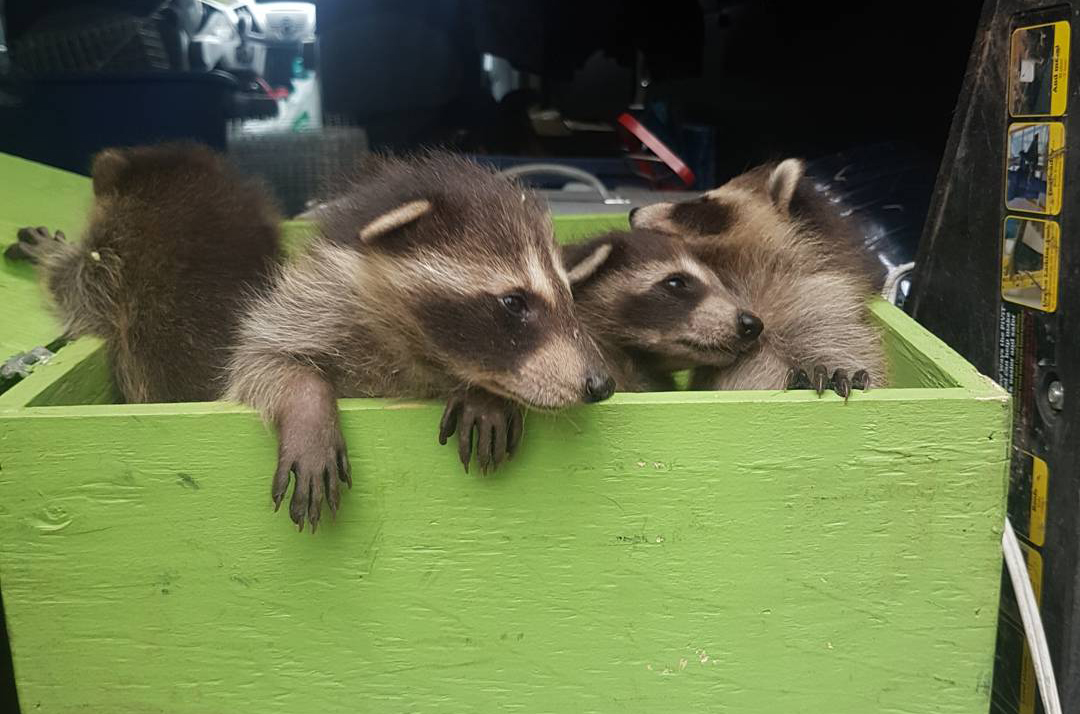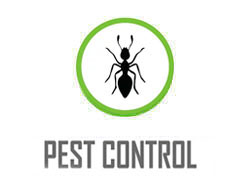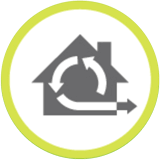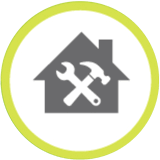
Need help today? Don't wait
> FIND A LOCATIONRaccoons
ABOUT RACCOONS AND THE RISK TO YOUR HOME
Raccoons develop their distinctive mask by the time they are ten days old. Although they’re admired for their intelligence and ingenuity, these attributes are also what make raccoons so destructive when they decide to live in your home. This nocturnal species is as comfortable in the city as it is in the forest and often makes its den inside warm and dry attics, chimneys and crawl spaces. Once inside your home raccoons can lead to sleepless nights for homeowners as well as costly repairs. The good news is that Skedaddle’s team of trained and experienced technicians are on your side to get the job done right the first time.
WHAT WE DO FOR YOU
The key to humanely and permanently resolving a raccoon problem is a proper game plan. Skedaddle technicians begin each raccoon removal with a thorough assessment of your home to understand how raccoons have made entry, where they might try to get in next and what kind of damage they have caused. Property assessments ensure that each and every raccoon entry point or vulnerability is identified and sealed in order to protect your property. Once they have had the chance to evaluate the situation, our friendly technicians will walk you through their findings and each step that we’ll take to remove the raccoons, clean up the mess they left behind, and stop them from returning.
No two raccoon removals are the exact same. Our knowledgeable technicians will use their years of experience to determine where the raccoons have made entry, where their den is and if there are any babies present. Understanding home construction as well as raccoon behaviour is key to effective removal. Hiring professionals that know which tools, techniques and strategies to use reduces property damage and saves homeowners money in the long run. Skedaddle’s hands-on approach to raccoon removal has been refined for over 30 years and is backed by a lifetime warranty. The team at Skedaddle is always available to help if any issues arise in the future, and ensure your raccoon problem has been solved for good.
WHY YOU NEED PROFESSIONAL RACCOON REMOVAL
Raccoons are clever creatures capable of making a small opening into a spacious entry point on just about any part of a property. The truth is that many of the materials used to construct our homes, including aluminium, vinyl and wood are no match for the strength and dexterity of a determined raccoon. Their job is made easier as our homes age and the amount of deterioration from weather damage over time. Roof vents, soffits and siding are just some of the common points of entry for raccoons into attics. With over three decades of experience, our team can handle any situation, big or small.
Once inside an attic, raccoons are capable of causing costly damage to attic insulation, electrical and duct work, and their droppings can create unhealthy conditions. Without the proper protective equipment and training, removing raccoons can be dangerous and lead to further contamination throughout the home. Skedaddle technicians come equipped with the latest safety tools and training to access the tight attics spaces that raccoons love to remove hazardous contaminants.
The arrival of baby raccoons brings a much higher degree of complexity to the raccoon removal process. During spring and summer, mother raccoons give birth to litters of babies ranging in size from two to six kits. The babies are born with their eyes closed and do not become mobile enough to leave the attic on their own until they are eight to twelve weeks old. That means the only way to remove the babies during this period is by hand.
Professional raccoon removal is critical during the birthing season when mother raccoons can be defensive of their young. Skedaddle’s technicians are trained to locate and remove each of the babies by hand, often with the help of thermal imaging cameras. Our technicians rely on their experience and specialty equipment to help locate and humanely remove the litter. Once outside, the babies will then be placed in a baby reunion box that keeps them warm and safe while they await their mother. Our technicians will then lure the mother raccoon out from the attic, reuniting the family. With her path back into the attic blocked, and any remaining vulnerabilities secured by our team, the mother must then move her litter to one of her other den sites in the area.

Raccoons on Your Property This Fall
As autumn arrives, raccoons begin preparing for the colder months by searching for warm and secure winter dens. Rather than hibernating, they enter a state of torpor that allows them to rest for extended periods and reduce their activity. This seasonal slowdown makes it harder to notice their presence once winter is underway, which is why fall is the ideal time to identify and address raccoon problems.
When raccoons settle inside a home, they quickly transform attics into dens. They pull apart insulation, leave behind droppings, and create an unsanitary environment that increases heating costs and poses health risks. In many cases, these spaces later become nurseries in the spring, which can make the problem even more complicated for homeowners.
Preventing raccoons from entering requires preparation before the cold sets in. Skilled climbers, raccoons often take advantage of damaged soffits, loose shingles, roof vents, and wall vents to gain entry. A detailed inspection of your roofline, attic, and weatherproofing helps identify the weak points that provide easy access for wildlife.
Acting early saves you the stress of dealing with raccoon families during winter or spring. If you suspect activity or want to ensure your property is secure, contact Skedaddle. Our experts provide humane removal, repair any damage caused by intruders, and install long-lasting solutions to keep raccoons out for good.
Our wildlife technicians are trained to identify all raccoon entry points into your roof or attic. With the help of thermal imaging technology, our technicians are able to locate the exact location of the raccoons and any babies that may be present. Once our technicians have a complete understanding of the situation, they will explain their findings and walk you through each step of the removal.
Any babies found inside your home will be hand removed and placed into a heated baby reunion box to wait for their mother. With her babies on the outside, the mother raccoon will be motivated to exit the attic and reunite herself with her offspring. Our technicians will prevent her re-entry to ensure she must relocate her babies to one of her multiple den sites in the area.
Why do Raccoons Live in Attics?
How Can I Tell If A Raccoon Has Babies?
How Can I Locate Raccoon Babies?
How to Remove Raccoons from an Attic?
Where Do Raccoon Families Go After Removal?
Skedaddle Humane Wildlife Control’s wildlife removal strategy is humane, safe and reliable. Part of our process involves clearing and cleaning any contaminated material that can cause serious health risks. It’s important to have raccoon contamination removed professionally because their feces commonly contains the eggs of a roundworm (Baylisascaris) that can cause serious illness if accidentally ingested.
Your wildlife technician will advise cleaning and clearing tactics, like insulation removal and attic restoration, depending on the severity of contamination. This will help ensure that your home remains safe for you and your family. Our clean up process ensures that bacteria and hazardous materials are not spread throughout the home, and we finish by applying a deodorising solution to eliminate any odours that may attract other raccoons to your home in the future.
How to Clean Raccoon Feces in the Attic
What Kind of Damage can Raccoons Do?
How to Safely Clean a Raccoon Latrine?
Tips on How to Deal With a Raccoon Infestation
The Health Risks of Raccoons Living in Your Attic
Part of Skedaddle Humane Wildlife Control’s process involves securing your home against future raccoon intrusions. Keeping in mind their dexterous paws, your wildlife technician will prevent re-entry into your home by identifying and securing all potential openings using heavy gauge screening.
With over three decades of experience, Skedaddle Humane Wildlife Control has the skill and know-how needed to keep even the most determined raccoon out of your attic or chimney. Our wildlife technicians specialize in ensuring that your home and family are protected as part of the Skedaddle Humane Wildlife Control customer service promise.
How do Raccoons Get into Houses?
How to Keep Raccoons off Roof?
Why Do It Yourself Measures Don’t Work for Raccoon Removal?
How to Effectively Prevent Raccoons from Choosing Your Home as their Nest?
COMMON RACCOON QUESTIONS & ANSWERS
HOW ARE RACCOONS GETTING INTO MY HOME?
Raccoons are great climbers that can easily access the roof of a home in search of vulnerable siding, shingles or other weak materials to make their way inside. Raccoons only need a four-inch-wide opening to squeeze their body through and can quickly widen a small gap with their strong paws and teeth. Soffits, roof vents and rotted wood are common elements on a home that raccoons use to access the attic.
HOW DO I KNOW IF BABY RACCOONS ARE IN MY HOME?
Raccoon litters arrive between the late weeks of February and into the early weeks of July. If you suspect you have an infestation during this time, babies are likely present as well. From birth, raccoon babies produce cries or chirps, similar to those of baby birds. During the first six weeks of their lives raccoon babies are completely immobible, so locating where their mother has stashed them away and removing them by hand is critical to success.
WHAT KIND OF DAMAGE CAN RACCOONS CAUSE?
The type and the amount of damage caused by raccoons depends on where they are living and how long they have had the chance to stay there. While in an attic space raccoons can trample and soil insulation and damage electrical wiring and duct work. The entry points they make to get inside an attic often allow for rain and snow infiltration into the home.
WHAT DISEASES DO RACCOONS CARRY?
Raccoons inside your home create serious health and safety concerns. Raccoon droppings have the potential for carrying diseases such as; leptospirosis, giardiasis and salmonella, which can be spread during an infestation. A parasitic roundworm known as baylisascaris, found in raccoon droppings, is commonly spread when the eggs inside their droppings are ingested by humans. Raccoons are also known carriers of rabies and can spread the virus to people or pets through a bite or scratch.
WHY DO RACCOONS LIVE IN CITIES?
Raccoons are the perfect urban animal. These nocturnal creatures have not only adapted to, but have learned to thrive, in our cities and residential communities because of an abundance of food and shelter opportunities. Discarded food found in garbage and green bins provides them with a steady diet, and attics, chimneys and sheds are secure den sites to raise babies and survive harsh weather.
CALL US TODAY
1.888.592.0387
OR
Request for Services






